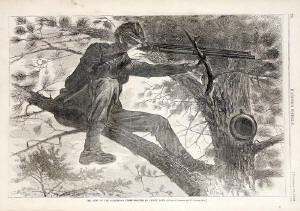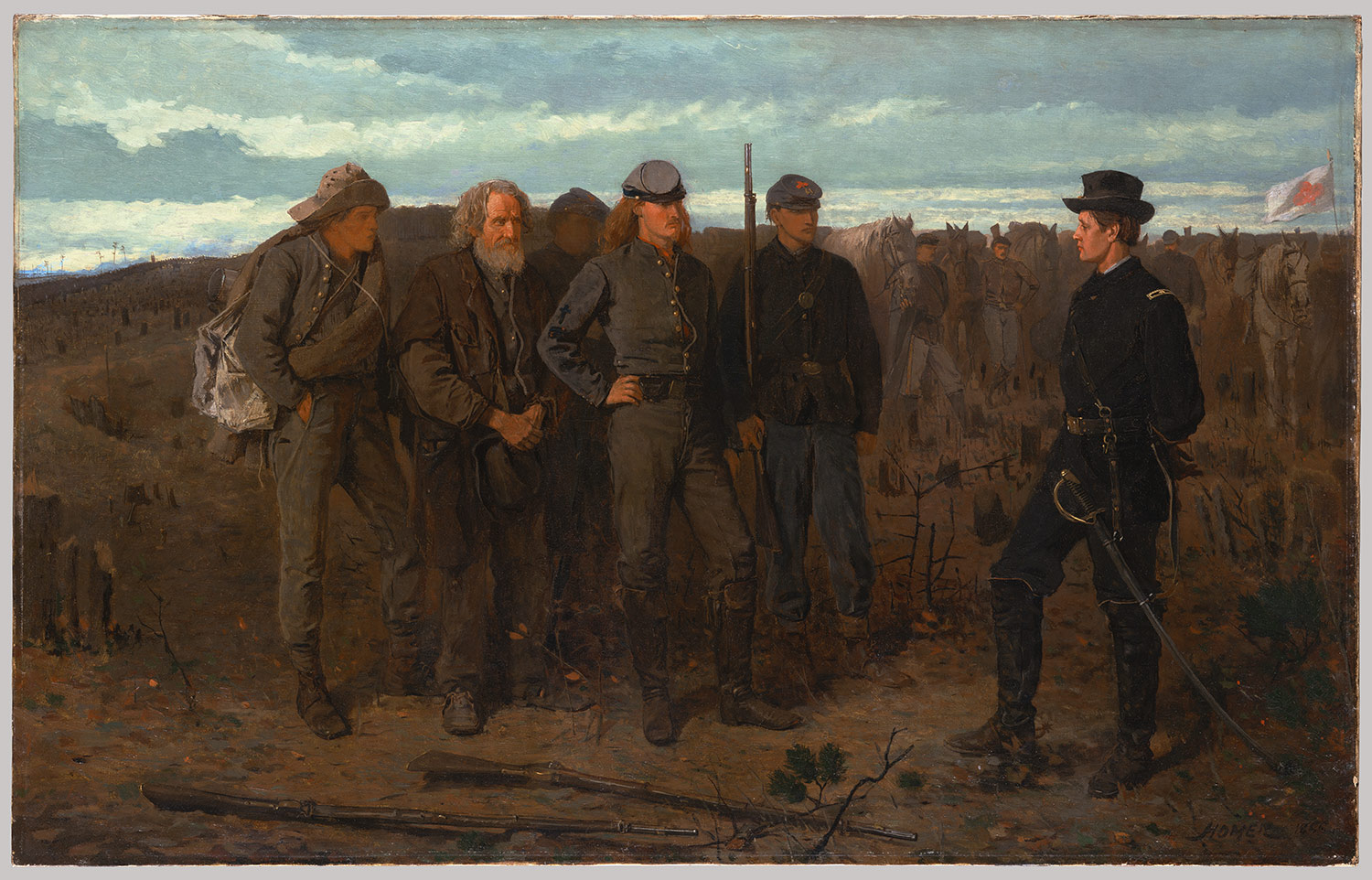In 1862, Homer created one of his most famous illustrations, titled The Sharpshooter on Picket Duty, shown below.

The woodblock print depicts a Union soldier perched in a tree, with a rifle in hand. The soldier appears to be getting close to getting a bead on his intended target. Improvements in technology allowed rifles to fire farther than ever before, allowing for soldiers to destroy their intended targets without said targets even knowing they were there. Because the soldier's target is not visible, the emotions normally associated with battle- fear, joy, anger, sorrow- are removed, making the affair of war much less personal and more methodical. It is a testament to our apparently inexhaustible ability to constantly find new ways to wage war, shown here with the implementation of guerilla tactics. Compare this work to the photo of a Palestenian child in a sniper's scope taken just a week or two ago.

Another work that Winslow painted on the Civil War was titled The Bright Side.

The work, this time done in oil paint, shows four fully-clothed African-American men resting on a Union soldier's tent. At the same time, the soldier in question is staring at the viewer by peeking out the tent. In the background are horses and Conestoga wagons. Captured in a fleeting moment inspired by ukiyo-e "floating world" prints from Japan, the camp appears to be resting, as the horses do not seem to be tied to the carriages. The title of this work is somewhat ironic, as the African-American men are former slaves that were freed as the Union army advanced south. The former slaves are effectively property of the Union army, but the "bright side" that the title mentions is that they are now no longer in the position of servitude that the Civil War was ultimately fought over, which begins bringing to light the more political side of the war.
If The Bright Side discusses the political side of the war as seen from the slaves' point of view, then another of Homer's works, Prisoners From the Front, captures the political side of the war as seen from the point of view of the soldiers of both the Union and Confederate armies.

The work features a scene taking place after a battle: a senior Union officer is about to take custody of a group of Confederate prisoners of war from a junior officer. Standing to the right, the senior officer stands straight, but appears relaxed and confident since he is standing at ease while he eyes the prisoners, particularly the young and feisty-looking one standing with his cap cocked to the side and one hand on his hip. The two older prisoners standing behind the young prisoner appear older and more ill-equipped for combat, as if they were pressed into service only a few days before going into battle. This is made more evident by their lack of uniform, but does not completely cover up their quiet defiance to the Union officers that are in custody of them.
The genius of Prisoners From the Front is that the painting can be seen from more than one perspective. Union sympathizers can admire the senior Union officer's poise and calm confidence in the face of even the most mundane of his tasks, while Confederate sympathizers can draw inspiration from the fighting spirit of the three prisoners. In fact, Prisoners From the Front was so popular at the time it was released that it was featured at the Universal Exhibition in Paris that same year in 1866, which also illustrates the point that industrialization allowed artists to travel the world in search of inspiration, similar to Paul Gauguin when he travelled to the South Pacific.
Painted in 1866, Prisoners From the Front is done in oil paint the same way that The Bright Side was. Since The Bright Side was painted in 1865, it is possible that Homer began both works after the war had ended, and thus he had more time to focus on painting the two works.
After the Civil War ended, Homer continued painting and eventually began dabbling in watercolor, as was the case with After The Hurricane in 1899.
http://www.vibe.com/article/israeli-sniper-posts-picture-child-crosshairs-online
http://www.sonofthesouth.net/Civil_War_Sharpshooter.htm
http://www.winslowhomer.org/
http://www.metmuseum.org/toah/works-of-art/22.207
http://www.civilwar.si.edu/homer_intro.html
http://www.artic.edu/aic/collections/artwork/16776

No comments:
Post a Comment